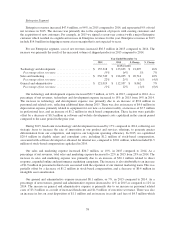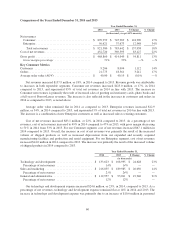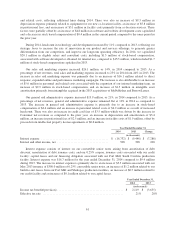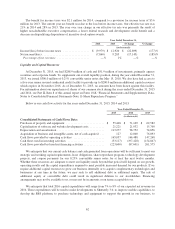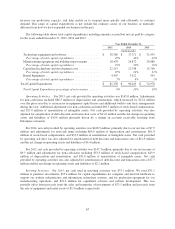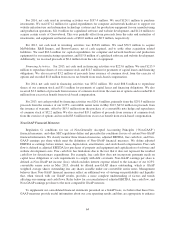Shutterfly 2015 Annual Report Download - page 57
Download and view the complete annual report
Please find page 57 of the 2015 Shutterfly annual report below. You can navigate through the pages in the report by either clicking on the pages listed below, or by using the keyword search tool below to find specific information within the annual report.value, a second step is performed to compute the amount of impairment as the difference between the estimated
fair value of goodwill and the carrying value. We estimate the fair value of the reporting units using discounted
cash flows. Forecasts of future cash flows are based on our best estimate of future net sales and operating
expenses, based primarily on expected reporting unit expansion, pricing, market segment share, and general
economic conditions.
Software and Website Development Costs. We capitalize costs associated with website development and
software developed or obtained for internal use. Accordingly, payroll and payroll-related costs and stock-based
compensation incurred in the development phase are capitalized and amortized over the product’s estimated
useful life, which is generally three years. Costs associated with minor enhancements and maintenance for our
website are expensed as incurred.
Income Taxes. We use the liability method of accounting for income taxes. Under this method, deferred tax
assets and liabilities are recognized by applying the statutory tax rates in effect in the years in which the
differences between the financial reporting and tax filing bases of existing assets and liabilities are expected to
reverse. We have considered cumulative earnings and projected future earnings in assessing the need for a
valuation allowance against our deferred tax assets. In 2015, our valuation allowance against certain California,
South Carolina, and Arizona deferred tax assets increased to $8.2 million from $4.9 million in 2014. Based on
our assessment, excluding the valuation allowance recorded related to certain Arizona, California and South
Carolina deferred tax assets that are not likely to be realized, it is more likely than not that the Company’s U.S.
net deferred tax asset will be realized through future taxable earnings, and/or the reversal of existing taxable
temporary differences as of December 31, 2015. Accordingly, with exception of the valuation allowance
discussed above, no additional valuation allowance has been recorded on net deferred tax assets as of
December 31, 2015. Our business is cyclical and taxable income is highly dependent on revenue that historically
has occurred during the fourth quarter. If there are changes to this historic trend and our fourth quarter does not
yield results in-line with expectations, we may not be profitable in a given year resulting in a potential
cumulative loss. If this were to occur, we would pursue any possible tax planning strategies that are feasible and
prudent to avoid the expiration of our tax attributes. We will continue to assess the need for a valuation
allowance in the future.
We report a liability for unrecognized tax benefits resulting from uncertain tax positions taken or expected to
be taken in a tax return. The application of income tax law is inherently complex. Laws and regulations in this
area are voluminous and are often ambiguous. We are required to make subjective assumptions and judgments
regarding our income tax exposures. Interpretations and guidance surrounding income tax laws and regulations
change over time. As such, changes in our subjective assumptions and judgments can materially affect amounts
recognized in the consolidated balance sheets and statements of operations.
Our policy is to recognize interest and/or penalties related to all tax positions in income tax expense. To the
extent that accrued interest and penalties do not ultimately become payable, amounts accrued will be reduced and
reflected as a reduction of the overall income tax provision in the period that such determination is made.
Stock-Based Compensation Expense. We measure our stock based awards at fair value and recognize
compensation expense for all share-based payment awards made to our employees and directors, including
employee stock options and restricted stock awards.
We estimate the fair value of stock options granted using the Black-Scholes valuation model. This model
requires us to make estimates and assumptions including, among other things, estimates regarding the length of
time an employee will retain vested stock options before exercising them, the estimated volatility of our common
stock price using historical and implied volatility and the number of options that will be forfeited prior to vesting.
The fair value is then amortized on a straight-line basis over the requisite service periods of the awards, which is
55















